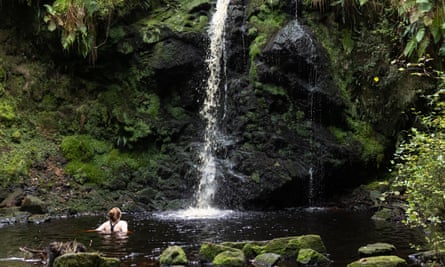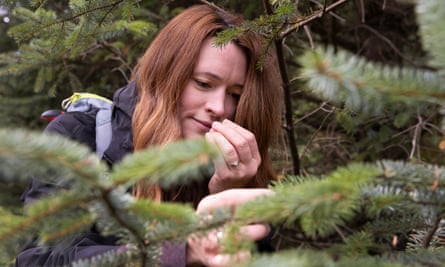There’s an old saying that the perfect walk has “something to see, somewhere to pee, and somewhere to get a cup of tea”. While those things do indeed make for a respectable hike, scientists have discovered that aspects of nature will turn a good walk into a great one, in intriguing ways.
Over recent years, it has become apparent that interacting with the great outdoors does wonders for our health, not only because it keeps our bodies physically fit but our brains, too. Last year, a long-term study of 2.3 million people in Wales revealed that the closer you live to nature, the lower your chances of having a mental health condition. “If people interacted with nature every day, it would be a gamechanger in terms of mental health,” says Michele Antonelli, a doctor at the Azienda Unità Sanitaria Locale (local health authority) for Reggio Emilia in Italy.
It has been found that certain natural elements – particular flowers, landscapes and scents – can boost the brain more than others. Using these new insights, I scoured the UK to find the ultimate mental health walk. It is around 24km (15 miles), needs no orienteering skills and begins at 8.15am in Kielderhead national nature reserve, three miles from the Scottish border near Kielder, one of the most remote villages in England.
Our hike begins early, not just because of its length, but because bright light first thing in the morning is a key step in ultimate wellbeing. Light affects our circadian rhythms, the internal metronomes that anchor us to our 24-hour day, and studies show that getting a good dose of sunshine in the morning helps us sleep at night.
The walk starts at Blakehopeburnhaugh farm, where a short detour into the nearby woods will lead you to Hindhope Linn, a small but enchanting waterfall that, despite being adequately signposted, is described by the Kielder forest park trail guide as one of the area’s best kept secrets. Nestled in a glen of glistening moss and under a canopy of Scots pine, the waterfall is easy to find, for those who want to dip a toe. I had more in mind – a 6ft rock provides the perfect spot to change into my swimsuit before I plunge into the waist-deep pool.

An avid fan of outdoor swimming, I’m used to the rush of adrenaline as I sink under the water, but it never fails to surprise me how good it feels. It’s September, so I’m not in for long, but I don’t need to be. Studies show that five minutes of cold-water immersion triggers physiological reactions that reduce fatigue, lessen symptoms of depression and elevate mood. The hormone cortisol, a key regulator of stress, decreases after swimming and can remain low for hours. These benefits can be gained from a single dip, so a pool of water was a non-negotiable start for my mental health hike.
Stepping back out on to Forest Drive we enter an ancient woodland. Looking at the symmetrical walls of pine that line our path, I wonder why their power over our mental health is not better utilised. Years of research shows how green spaces lower stress and increase our ability to perform, yet we don’t take advantage, says Antonelli. Children who look out of a window and see greenery during a test score higher and are faster to recover from the stress of the exam than those who look out on a brick wall, for instance. “How easy would it be for schools to grow ivy up their walls,” remarks Kathy Willis, professor of biodiversity at the University of Oxford and author of Good Nature:The New Science of How Nature Improves Our Health.
The power of nature to focus our attention and decrease our stress levels is not just about its pleasing aesthetics but ties in with an idea known as attention restoration theory. During the day, we direct our attention to a number of tasks – reading emails, writing reports, scheduling meetings, all the while ignoring distractions. It’s what’s known as “top-down attention” – our thoughts direct our actions. But this attention is cognitively exhausting so we can’t sustain it for long and quickly lose focus and self-control. Nature triggers what’s known as “soft fascination”. It contains stimuli that catch our attention and are less cognitively demanding – creating what’s known as “bottom-up attention”; this gives the brain a chance to recover.

Forests are the ideal environment for a mental minibreak, but this particular one offers a lot more. The tall walls of Sitka spruce and Scots pine are bordered by tufted hairgrass. Together, they form the perfect palette, not just in their beauty, but because small studies suggest that yellows and greens have the strongest effect on neuronal activity associated with a calm state.
The forest’s scent is also significant. Crouching low, I pick a small amount of pine needles from a nearby tree, crush them and inhale deeply. The smell triggers happy memories of Christmas. Yet it offers more than nostalgia.
Trees release volatile organic compounds (VOCs) to ward off parasites, but their odour activates nerves that influence human hormones and other physiological processes. They are also absorbed through the lungs into our blood. “Smell is the most fascinating sense when it comes to the impact of nature on your wellbeing,” says Willis. “Smell directly influences your blood in a way that sight and sound cannot.”
I chose a walk with plenty of pine and spruce because they release two particularly interesting VOCs: pinene and limonene. Studies show that these chemicals reduce cortisol, lower blood pressure and boost mood. Spending at least 20 minutes in the woods will have an effect, but Antonelli recommends longer. “Spend six hours among the trees and you’ll see beneficial effects for days,” he says. “Spend days in the forest and the effects can last a month.”

We spend two and half hours walking along this path, absorbing its sensory gifts. Then the trees part and we emerge, straight on to wide open moorland. The view is spectacular. I spent hours poring over maps and satellite imagery to find a landscape exactly like this. Not because of its beauty, but for its fractal dimensions.
A fractal is essentially a pattern that repeats at smaller and smaller scales. A fractal’s complexity is known as its D-value. A straight line would have a D-value of 1, whereas a dense forest with its patterns of branches and twigs would be closer to 2. Fractals are of interest because it turns out that we prefer to look at landscapes with a D-value of around 1.3. “These types of landscapes tend to be open savannahs with a few dotted trees,” says Willis. We may be drawn to these savannah-type landscapes because they were once a place where you could easily spot danger, while still providing some shelter, although it’s hard to find strong evidence to support this idea, says Willis. What we do know is that these landscapes generate brainwaves associated with relaxation and focus, while dampening those associated with fatigue, making them ideal for mental wellbeing.
“It really does make you feel more relaxed,” says my walking partner Jess, staring out at the scene from Blakehope Nick, a large sculpture created as a beacon from which to observe the dramatic open landscape.

I thought a lot about whether to walk alone or with a friend. Done correctly, time alone is a powerful modulator of mental health. Studies by author Heather Hansen and researchers at the Universities of Reading and Durham show that just 15 minutes of chosen solitude can reduce feelings of anxiety and increase calmness. But Hansen also tells me that solitude doesn’t always mean being physically distant from others. “‘Companion solitude’ is where you are in the company of another but there is a trust there, an ease,” she says. “You can gain the same benefits as long as you are free of expectations and have time for your own thoughts.”
After lunch, Jess and I begin our undulating descent back into the forest. The landscape is now more varied: larch, birch, rowan, cherry, beech and willow join shrubs and wildflowers. This biodiversity was another appealing aspect of the area. In June, researchers found a link between the diversity of trees and birds and the mental health of people in different Canadian cities. Living in a region that had more tree species increased the likelihood of reporting good mental health.
The reason may in part be our microbiome – the bacteria, viruses and fungi that live in our guts and influence our mental health. Some studies suggest exposure to diverse environments such as this one can – at least in the short term – enrich the microbiome, which could help improve mood and reduce risk of conditions such as depression.

As we get lower, we pass small tributaries, flowing towards Kielder Water, northern Europe’s largest human-made lake. Incorporating water into this walk was essential. Dr Mathew White at the University of Exeter and colleagues showed that living near blue spaces increases our mental wellbeing more than living near green spaces – although the best scenario according to their work is living somewhere where the two meet. “A good hike for mental health would usually include some water,” says White. Blue spaces, with their soft sounds and changing patterns, help us achieve that bottom-up attention that gently draws our brains away from rumination and towards a more restful mindset.
It is as the sun sets, however, that we discover why this walk is truly special. Kielder is at the centre of one of Europe’s largest areas of protected night sky. Streetlamps here are nonexistent. Whether you choose to visit Kielder observatory, or simply sit and observe the stars from the lake, I urge you to finish the walk looking up. Without light pollution, the stars shine brighter here than anywhere else in England.
In doing so you have a high chance of experiencing awe, which scientists have recently come to agree has a host of benefits. According to Dacher Keltner at the University of California, Berkeley, awe fosters wonder, your self dissolves and you feel part of something much bigger. The psychology professor and his colleagues have shown that this makes people happier, less stressed, calms our fight or flight response and even reduces inflammation, which is associated with mood imbalances.
Staring at Vega, the brightest star in the constellation of Lyra, I experienced such a moment, plus an overwhelming feeling of calm that has stayed with me since. When that fades, I will head to my local park for my next dose of nature. It may not encompass the perfect trees or the right type of flower but, as Antonelli says, any interaction with green or blue space is better than none.
“If people realised how good nature can be for them, we wouldn’t be giving out ‘green prescriptions’ as a treatment but as a preventive measure, to stop mental health conditions happening in the first place,” says Antonelli. “Nature is free, and the best kind of medicine. I truly believe that.”
.png)
 1 month ago
3
1 month ago
3









 English (US) ·
English (US) ·